B visa

A B visa is one of a category of non-immigrant visas issued by the United States government to foreign citizens seeking entry for a temporary period. The two types of B visa are the B-1 visa, issued to those seeking entry for business purposes, and the B-2 visa, issued to those seeking entry for tourism or other non-business purposes. In practice, the two visa categories are usually combined together and issued as a "B-1/B-2 visa" valid for a temporary visit for either business or pleasure, or a combination of the two. Visitors from some countries do not need to obtain a visa for these purposes (see United States visas).
Cost
The cost of a B visa consists of the application fee, which all applicants must pay (currently 160 USD[1]), and the issuance fee, which varies by nation, based on a fee reciprocity table.[2]
Currently, as of October 2014, nationals of the following countries have to pay the reciprocity fee.[3]
| Country | Price (US$) |
|---|---|
| | 10 |
| | 32 |
| | 240 |
| | 40 |
| | 31 |
| | 20 |
| | 150 |
| | 160 |
| | 45 |
| | 10 |
| | 70 |
| | 15 |
| | 15 |
| | 19 |
| | 355 |
| | 30 |
Validity period and duration of stay

As with other non-immigrant U.S. visas, a B-1/B-2 visa has a validity period (from 1 to 10 years), allows for either one or multiple entries into the U.S, and elicits a period of stay (maximum 6 months) recorded by the Customs and Border Protection officer at the port of entry on the individual's form I-94.[4]
Validity periods per country are listed in the U.S. Department of State Visa Reciprocity Tables and vary from 1 month for DR Congo, 3 years for Russia, and 5 years for Pakistan, to 10 years for Argentina, Bolivia, Brazil, Colombia, Hong Kong, India, Israel, Japan, Malaysia, Mexico, Morocco, Singapore, South Africa, Tunisia and most European Countries.
Periods of stay for B-1 visas may be granted initially for a duration long enough to allow the visitor to conduct their business, up to a maximum of 6 months, and can be extended for another 6 months;[5] B-1 visas are usually granted for three months or less, while B-2 visas are generally granted for six months.[6] Extensions are possible, provided the individual has not violated the conditions of their admission.[7]
A Border Crossing Card (BCC), also called a laser visa, has a 10-year validity and functions as both a BCC and a B-1/B-2 visitor's visa.[8]
Validity of visas by nationality for B-1/B-2 visa:[9]
| Country | Validity (in months) |
|---|---|
| Afghanistan | 12 |
| Albania | 36 |
| Algeria | 24 |
| Angola | 24 |
| Antigua and Barbuda | 120 |
| Argentina | 120 |
| Armenia | 120 |
| Australia | 12 |
| Azerbaijan | 12 |
| Bahrain | 60 |
| Bangladesh | 60 |
| Barbados | 120 |
| Belarus | 12 |
| Belize | 120 |
| Benin | 36 |
| Bhutan | 3[10] |
| Bolivia | 120 |
| Bosnia-Herzegovina | 120 |
| Botswana | 120 |
| Brazil | 120 |
| Bulgaria | 120 |
| Burkina Faso | 60 |
| Burma | 3[11] |
| Burundi | 12 |
| Cambodia | 3[12] |
| Cameroon | 12 |
| Canada | 120 |
| Cape Verde | 60 |
| Central African Republic | 12 |
| Chad | 3[13] |
| China | 120 |
| Colombia | 120 |
| Comoros | 45 days[14] |
| Congo (Brazzaville) | 6 |
| Congo (Kinshasa) | 1 |
| Costa Rica | 120 |
| Côte d'Ivoire | 12 |
| Croatia | 120 |
| Cuba | 6 |
| Cyprus | 120 |
| Djibouti | 12 |
| Dominica | 120 |
| Dominican Republic | 120 |
| Ecuador | 60 |
| Egypt | 60 |
| El Salvador | 120 |
| Equatorial Guinea | 60 |
| Eritrea | 12 |
| Ethiopia | 24 |
| Fiji | 120 |
| Gabon | 60 |
| Georgia | 120 |
| Ghana | 60 |
| Grenada | 120 |
| Guatemala | 120 |
| Guinea | 36 |
| Guinea - Bissau | 60 |
| Guyana | 120 |
| Haiti | 60 |
| Honduras | 120 |
| Hong Kong | 120 |
| India | 120 |
| Indonesia | 60 |
| Iran | 3[15] |
| Iraq | 12 |
| Israel | 120 |
| Jamaica | 120 |
| Jordan | 60 |
| Kazakhstan | 60 |
| Kenya | 60 |
| Kiribati | 48 |
| Kosovo | 36 |
| Kuwait | 120 |
| Kyrgyzstan | 60 |
| Laos | 3[16] |
| Lebanon | 60 |
| Lesotho | 120 |
| Liberia | 12 |
| Libya | 3[17] |
| Macau | 120 |
| Macedonia | 120 |
| Madagascar | 3 |
| Malawi | 3[18] |
| Malaysia | 120 |
| Maldives | 120 |
| Mali | 60 |
| Marshall Islands | 3 |
| Mauritania | 12 |
| Mauritius | 120 |
| Mexico | 120 |
| Micronesia | 3 |
| Moldova | 120 |
| Mongolia | 120 |
| Montenegro | 36 |
| Morocco | 120 |
| Mozambique | 12 |
| Namibia | 60 |
| Nauru | 60 |
| Nepal | 60 |
| Nicaragua | 120 |
| Niger | 12 |
| Nigeria | 24 |
| Oman | 24 |
| Pakistan | 60 |
| Palau | 3 |
| Palestinian Authority | 120 |
| Panama | 120 |
| Papua New Guinea | 12 |
| Paraguay | 120 |
| North Korea | 3[19] |
| Peru | 120 |
| Philippines | 120 |
| Poland | 120 |
| Qatar | 120 |
| Romania | 120 |
| Russia | 36 |
| Rwanda | 120 |
| Saint Kitts and Nevis | 120 |
| Saint Lucia | 120 |
| Saint Vincent and the Grenadines | 120 |
| Samoa | 120 |
| Sao Tome And Principe | 6 |
| Saudi Arabia | 60 |
| Senegal | 120 |
| Serbia | 120 |
| Seychelles | 120 |
| Sierra Leone | 36 |
| Solomon Islands | 60 |
| Somalia | 3[20] |
| South Africa | 120 |
| South Sudan | 3[21] |
| Sri Lanka | 60 |
| Sudan | 3[22] |
| Suriname | 60 |
| Swaziland | 120 |
| Syria | 24 |
| Taiwan | 60 |
| Tajikistan | 12 |
| Tanzania | 12 |
| Thailand | 120 |
| The Bahamas | 120 |
| The Gambia | 60 |
| Timor-Leste | 3[23] |
| Togo | 36 |
| Tonga | 120 |
| Trinidad And Tobago | 120 |
| Tunisia | 120 |
| Turkey | 120 |
| Turkmenistan | 12 |
| Tuvalu | 120 |
| Uganda | 24 |
| Ukraine | 120 |
| United Arab Emirates | 120 |
| Uruguay | 120 |
| Uzbekistan | 12 |
| Vanuatu | 60 |
| Vatican City | 60 |
| Venezuela | 120 |
| Vietnam | 12 |
| VWP countries[24] | 120 |
| Yemen | 12 |
| Zambia | 36 |
| Zimbabwe | 12 |
Visitor visa statistics
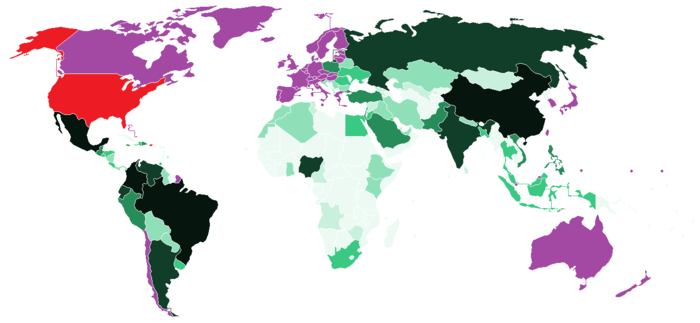
In fiscal 2014 most B-1,2 visas were issued to the nationals of the following countries (listed over 40,000 visas):[25]
| Nationality | Issued B-1,2 visas in 2014 |
|---|---|
| | 1,403,617 |
| | 1,266,781 |
| | 1,021,561 |
| | 452,525 |
| | 436,769 |
| | 217,861 |
| | 206,049 |
| | 156,638 |
| | 156,092 |
| | 124,805 |
| | 94,857 |
| | 88,735 |
| | 81,371 |
| | 77,882 |
| | 75,404 |
| | 69,982 |
| | 67,140 |
| | 66,523 |
| | 55,353 |
| | 53,569 |
| | 53,549 |
| | 47,535 |
| | 47,387 |
| | 47,155 |
| | 46,844 |
| | 46,682 |
| | 42,780 |
| | 41,600 |
In fiscal 2014 most reasons to refuse a visa were cited as "failure to establish entitlement to nonimmigrant status", "incompatible application" (most overcome), "unlawful presence", "misrepresentation", "criminal convictions", "smugglers" and "controlled substance violators". Smaller number of applications were rejected for "physical or mental disorder", "prostitution", "espionage", "terrorist activities", "falsely claiming citizenship" and other grounds for refusal including "presidential proclamation", "money laundering", "communicable disease" and "commission of acts of torture or extrajudicial killings".[27]
Admission statistics

Highest number of non-immigrant admissions for tourists and business purposes into the United States in fiscal year 2013 was from the following countries (listed over 700,000 admissions):[28]
| Country | FY 2013 |
|---|---|
| | 16,925,645 |
| | 4,333,518 |
| | 4,051,814 |
| | 3,003,317 |
| | 2,212,435 |
| | 2,035,737 |
| | 1,829,304 |
| | 1,623,290 |
| | 1,454,738 |
| | 1,376,715 |
| | 1,133,189 |
| | 970,416 |
| | 858,402 |
| | 773,375 |
| | 762,313 |
| | 741,859 |
| | 707,863 |
| Total (worldwide) | 54,645,551 |
Overstay rate
A number of visitors from overstayed the maximum allowed stay on their B-1/B-2 visa. The Department of Homeland Security published a report for 2015 that lists the number of violations made by passengers who arrived via air and sea. The table below excludes statistics on persons who left the United States later than their allowed stay or legalized their status and shows only suspected overstays who remained in the country.
The top 20 countries of nationality by the number of suspected in-country B-1/B-2 overstays (out of total 210,825) are:[29]
| Overstay number | ||
|---|---|---|
| Country | Number of suspected in-country overstays | In-country overstay rate (against total number of expected departures) |
| Brazil | 35,707 | 1.52% |
| Colombia | 16,434 | 1.76% |
| China | 15,692 | 0.89% |
| India | 12,885 | 1.46% |
| Venezuela | 12,242 | 2.13% |
| Argentina | 7,498 | 1.09% |
| Dominican Republic | 6,990 | 2.31% |
| Nigeria | 6,781 | 3.69% |
| Jamaica | 6,614 | 2.75% |
| Ecuador | 5,612 | 1.61% |
| Guatemala | 5,419 | 2.30% |
| Peru | 4,550 | 1.70% |
| Honduras | 4,075 | 2.52% |
| Haiti | 3,312 | 2.72% |
| Philippines | 3,265 | 1.44% |
| El Salvador | 3,118 | 2.27% |
| Russia | 2,705 | 0.94% |
| Israel | 2,375 | 0.67% |
| Poland | 2,345 | 1.37% |
| Ukraine | 2,299 | 3.14% |
| Vietnam | 2,285 | 3.14% |
The top 10 countries of nationality by in-country B-1/B-2 visa overstay rate are:[30]
| Overstay rate | |
|---|---|
| Country | In-country overstay rate (against total number of expected departures) |
| Djibouti | 26.80% |
| Bhutan | 23.98% |
| Burkina Faso | 17.37% |
| Laos | 16.66% |
| Eritrea | 16.33% |
| Chad | 15.36% |
| Mauritania | 12.62% |
| Georgia | 12.24% |
| Afghanistan | 10.25% |
| Gambia | 10.08% |
Use for other countries
US tourist visas that are valid for further travel are accepted as substitute visas for national visas in following countries:
 Albania — 90 days;
Albania — 90 days;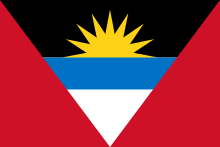 Antigua and Barbuda — 30 days; USD 100 visa waiver fee applies.
Antigua and Barbuda — 30 days; USD 100 visa waiver fee applies.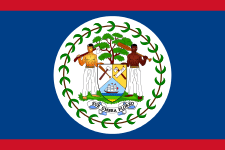 Belize — 30 days; USD 50 visa waiver fee applies.
Belize — 30 days; USD 50 visa waiver fee applies. Chile — 90 days; for nationals of China only.
Chile — 90 days; for nationals of China only.  Colombia — 90 days;
Colombia — 90 days;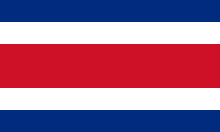 Costa Rica — 30 days or less if the visa is about to expire; must hold a multiple entry visa.
Costa Rica — 30 days or less if the visa is about to expire; must hold a multiple entry visa. Dominican Republic — 90 days;
Dominican Republic — 90 days; El Salvador — 90 days; not applicable to all nationalities.
El Salvador — 90 days; not applicable to all nationalities. Georgia — 90 days within any 180 day period;
Georgia — 90 days within any 180 day period; Guatemala — 90 days; not applicable to all nationalities.
Guatemala — 90 days; not applicable to all nationalities. Honduras — 90 days; not applicable to all nationalities.
Honduras — 90 days; not applicable to all nationalities. Jamaica — 30 days; not applicable to all nationalities.
Jamaica — 30 days; not applicable to all nationalities. Mexico — 180 days;[31][32]
Mexico — 180 days;[31][32] Montenegro — 30 days;
Montenegro — 30 days; Nicaragua — 90 days; not applicable to all nationalities.
Nicaragua — 90 days; not applicable to all nationalities. Panama — 30/180 days; must hold a visa valid for at least 2 more entries.
Panama — 30/180 days; must hold a visa valid for at least 2 more entries. Philippines — 7 days; for nationals of China and India only.
Philippines — 7 days; for nationals of China and India only.  Serbia — 90 days;
Serbia — 90 days; Taiwan — certain nationalities can obtain an online travel authority if holding a valid US visa.
Taiwan — certain nationalities can obtain an online travel authority if holding a valid US visa. Turkey — certain nationalities can obtain an electronic Turkish visa if holding a valid US visa.
Turkey — certain nationalities can obtain an electronic Turkish visa if holding a valid US visa.
Requirement to overcome presumption of intending immigrant
Under section 214(b) of the Immigration and Nationality Act, a foreigner must prove to the satisfaction of the Consular officer his or her intent to return to his home country after visiting the United States. The act specifically states:
| “ | Every alien (other than a nonimmigrant described in subparagraph (L) or (V) of section 101(a)(15), and other than a nonimmigrant described in any provision of section 101(a)(15)(H)(i) except subclause (b1) of such section) shall be presumed to be an immigrant until he establishes to the satisfaction of the consular officer, at the time of application for a visa, and the immigration officers, at the time of application for admission, that he is entitled to a nonimmigrant status under section 101(a)(15) | ” |
In practice, this means that consular officers have wide discretion to deny a visa application. Once refused, there is no judicial or other means to challenge a visa decision. The foreigner, however, is free to apply for a visa again, particularly if circumstances have changed that might show to the consular officer that the applicant overcomes the presumption of being an intending immigrant.[34]
Uses of a B-1/B-2 visa
Business or pleasure cover a wide variety of possible reasons to visit the United States. Under the category of temporary visitor for business, it can be used to:
- Negotiate and sign contracts
- Purchase supplies or materials
- Hold business meetings or attend/exhibit at a convention
- Settle an estate
- Interview and hire staff
- Conduct research
- Sit different types of exams and tests held inside the United States
- Perform certain professional services.[35]
Under the category of temporary visitor for pleasure, a B-2 visa can be used to:
- Travel within the U.S.
- Visit family or friends
- Participate in activities of a fraternal, social, or service nature
- Obtain medical treatment
The B-2 visa can also be used by cohabiting (unmarried) partners of non-immigrant visa holders.[36]
Adjusted Visa refusal Rate
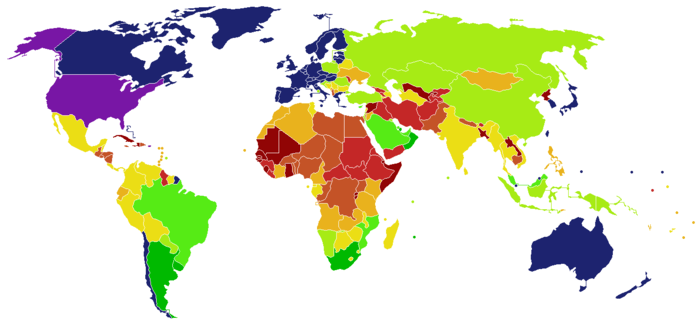
The Adjusted Visa Refusal Rate for fiscal year 2014 for B visas were:[37]
| Country | Rate 2008[38] | Rate 2014 |
|---|---|---|
| Afghanistan | 51.0% | 46.7% |
| Albania | 38.7% | 39.8% |
| Algeria | 20.3% | 23.1% |
| Angola | 17.1% | 21.4% |
| Antigua and Barbuda | 21.7% | 20.8% |
| Argentina | 3.1% | 1.4% |
| Armenia | 53.3% | 43.8% |
| Azerbaijan | 14.0% | 13.5% |
| Bahrain | 6.6% | 4.7% |
| Bangladesh | 48.2% | 50.8% |
| Barbados | 10.1% | 9.8% |
| Belarus | 21.1% | 14.0% |
| Belize | 25.4% | 16.4% |
| Benin | 39.1% | 31.4% |
| Bhutan | 48.3% | 43.6% |
| Bolivia | 23.6% | 13.6% |
| Bosnia-Herzegovina | 21.3% | 16.1% |
| Botswana | 15.6% | 16.9% |
| Brazil | 5.5% | 3.2% |
| Bulgaria | 13.3% | 15.2% |
| Burkina Faso | 44.4% | 37.4% |
| Burma | 41.9% | 15.5% |
| Burundi | 58.8% | 50.0% |
| Cambodia | 44.3% | 39.9% |
| Cameroon | 46.7% | 28.2% |
| Cape Verde | 42.7% | 28.7% |
| Central African Republic | 39.6% | 46.6% |
| Chad | 41.4% | 32.4% |
| China | 18.2% | 9.0% |
| Colombia | 25.6% | 12.3% |
| Comoros | 14.0% | 17.0% |
| Congo (Brazzaville) | 33.2% | 35.4% |
| Congo (Kinshasa) | 36.2% | 39.1% |
| Costa Rica | 21.2% | 11.4% |
| Côte d'Ivoire | 40.9% | 29.8% |
| Croatia | 5.1% | 6.1% |
| Cuba | 45.2% | 66.2% |
| Cyprus | 1.7% | 3.5% |
| Djibouti | 42.5% | 50.1% |
| Dominica | 29.5% | 29.0% |
| Dominican Republic | 45.6% | 35.9% |
| Ecuador | 40.0% | 20.8% |
| Egypt | 35.3% | 34.0% |
| El Salvador | 45.7% | 36.3% |
| Equatorial Guinea | 11.1% | 17.8% |
| Eritrea | 51.1% | 41.7% |
| Ethiopia | 46.7% | 44.9% |
| Fiji | 38.0% | 14.0% |
| Gabon | 23.0% | 13.5% |
| Georgia | 46.6% | 48.2% |
| Ghana | 50.1% | 59.8% |
| Grenada | 29.9% | 29.5% |
| Guatemala | 33.8% | 35.9% |
| Guinea | 63.8% | 47.8% |
| Guinea - Bissau | 63.4% | 56.5% |
| Guyana | 56.6% | 40.2% |
| Haiti | 54.4% | 58.2% |
| Honduras | 33.6% | 36.8% |
| Hong Kong | 3.3% | 3.1% |
| India | 24.7% | 19.8% |
| Indonesia | 37.0% | 8.3% |
| Iran | 42.5% | 41.8% |
| Iraq | 46.3% | 41.4% |
| Israel | 3.0% | 8.2% |
| Jamaica | 35.5% | 32.3% |
| Jordan | 43.2% | 26.9% |
| Kazakhstan | 11.7% | 9.9% |
| Kenya | 35.6% | 27.3% |
| Kiribati | 26.2% | 15.4% |
| Kosovo | 47.9% | 38.1% |
| Kuwait | 6.5% | 5.7% |
| Kyrgyzstan | 32.1% | 43.2% |
| Laos | 73.4% | 61.1% |
| Lebanon | 27.9% | 16.1% |
| Lesotho | 32.1% | 16.7% |
| Liberia | 70.7% | 49.4% |
| Libya | 27.1% | 33.9% |
| Macedonia | 33.5% | 29.8% |
| Madagascar | 11.9% | 11.6% |
| Malawi | 28.9% | 12.3% |
| Malaysia | 5.6% | 4.6% |
| Maldives | 4.7% | 6.7% |
| Mali | 48.1% | 54.0% |
| Mauritania | 51.0% | 52.2% |
| Mauritius | 11.6% | 2.2% |
| Mexico | 11.4% | 15.6% |
| Moldova | 36.7% | 40.1% |
| Mongolia | 53.6% | 27.9% |
| Montenegro | 25.6% | 28.0% |
| Morocco | 24.0% | 21.9% |
| Mozambique | 13.8% | 4.0% |
| Namibia | 6.8% | 7.6% |
| Nauru | 66.7% | 42.9% |
| Nepal | 51.2% | 38.2% |
| Nicaragua | 41.8% | 35.8% |
| Niger | 55.7% | 36.4% |
| Nigeria | 36.0% | 33.2% |
| Oman | 2.2% | 2.1% |
| Pakistan | 46.3% | 38.0% |
| Palestinian Authority | 55.6% | 36.7% |
| Panama | 19.2% | 10.0% |
| Papua New Guinea | 3.4% | 7.4% |
| Paraguay | 14.4% | 6.1% |
| People's Republic Of Korea | 16.3% | 55.6% |
| Peru | 37.7% | 13.8% |
| Philippines | 31.0% | 24.6% |
| Poland | 13.8% | 6.4% |
| Qatar | 4.9% | 2.1% |
| Romania | 25.0% | 9.8% |
| Russia | 7.5% | 7.8% |
| Rwanda | 50.3% | 51.1% |
| Samoa | 32.4% | 27.2% |
| Sao Tome And Principe | 28.6% | 10.7% |
| Saudi Arabia | 6.6% | 3.3% |
| Senegal | 55.2% | 57.5% |
| Serbia | 11.7% | 16.0% |
| Seychelles | 18.0% | 6.8% |
| Sierra Leone | 50.1% | 51.9% |
| Solomon Islands | 6.5% | 5.4% |
| Somalia | 54.0% | 52.0% |
| South Africa | 4.6% | 2.6% |
| South Sudan | N/A | 43.8% |
| Sri Lanka | 31.4% | 19.5% |
| St. Kitts And Nevis | 25.0% | 27.5% |
| St. Lucia | 26.6% | 27.6% |
| St. Vincent And The Grenadines | 26.4% | 24.1% |
| Sudan | 38.6% | 42.4% |
| Suriname | 9.6% | 13.6% |
| Swaziland | 13.0% | 10.0% |
| Syria | 33.1% | 60.0% |
| Tajikistan | 32.4% | 49.0% |
| Tanzania | 26.2% | 21.3% |
| Thailand | 19.8% | 10.2% |
| The Gambia | 55.7% | 69.3% |
| Timor-Leste | 16.7% | 25.0% |
| Togo | 51.7% | 35.6% |
| Tonga | 48.7% | 25.4% |
| Trinidad And Tobago | 23.8% | 21.2% |
| Tunisia | 23.9% | 17.5% |
| Turkey | 11.2% | 7.1% |
| Turkmenistan | 45.4% | 18.6% |
| Tuvalu | 17.6% | 27.3% |
| Uganda | 34.4 | 37.2% |
| Ukraine | 30.9% | 27.7% |
| United Arab Emirates | 10.4% | 4.8% |
| Uruguay | 9.5% | 1.8% |
| Uzbekistan | 61.1% | 52.1% |
| Vanuatu | 16.7% | 20.0% |
| Vatican City | 16.7% | 7.7% |
| Venezuela | 25.4% | 15.2% |
| Vietnam | 38.8% | 14.3% |
| Yemen | 54.7% | 44.2% |
| Zambia | 53.3% | 22.2% |
| Zimbabwe | 30.3% | 13.2% |
See also
External links
References
- ↑ "Fees for Visa Services". United States Department of State. Retrieved 2011-11-02.
- ↑ "Reciprocity by Country". United States Department of State. Retrieved 2011-11-02.
- ↑
- ↑ "Difference between visa stamp and arrival departure record". immihelp.com. Retrieved 2011-11-02.
- ↑ "B-1 Temporary Business Visitor". USCIS. Retrieved 2011-10-24.
- ↑ "B Visa Overview | Immigration.Com - Law Offices of Rajiv S. Khanna, PC". Immigration.Com. Retrieved 2011-02-14.
- ↑ "Extend Your Stay". USCIS. Retrieved 2011-10-24.
- ↑ http://www.traveldocs.com/us/er.htm#bcc
- ↑ Visa Reciprocity Tables
- ↑ Single entry
- ↑ Single entry
- ↑ Double entry
- ↑ Single entry
- ↑ Single entry
- ↑ Single entry
- ↑ Single entry
- ↑ Single entry
- ↑ Single entry
- ↑ Double entry.
- ↑ Single entry
- ↑ Double entry.
- ↑ Single entry
- ↑ Double entry.
- ↑ Except Australia and Taiwan.
- ↑
- ↑ Including Border Crossing Cards
- ↑
- ↑ 2013 Yearbook of Immigration Statistics
- ↑ Entry/Exit Overstay Report Fiscal Year 2015
- ↑
- ↑ Countries and regions that require a visa to travel to Mexico, Instituto Nacional de Migración, September 27, 2013.
- ↑ Timatic - Visa information for Mexico
- ↑ "INA: ACT 214 - ADMISSION OF NONIMMIGRANTS". USCIS.
- ↑ "A 214(b) Denial: What it Means, What You Can Do." http://www.usvisalawyers.co.uk/article20.htm , website of Gudeon & McFadden law firm, accessed 22 September 2012.
- ↑ "Working (Legally) on a Visitor's Visa or Visa Waiver Entry". Retrieved 15 October 2012.
- ↑ http://travel.state.gov/visa/laws/telegrams/telegrams_1414.html
- ↑ Adjusted Refusal Rate 2014
- ↑
| ||||||